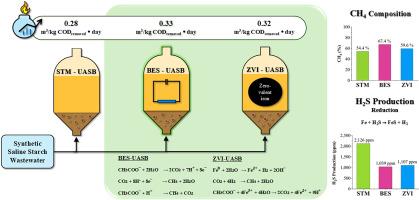通过先进的UASB系统提高富含生物质的含盐淀粉废水的生物能源回收:生物电化学和铁基策略的作用
IF 5.8
2区 生物学
Q1 AGRICULTURAL ENGINEERING
引用次数: 0
摘要
改性木薯淀粉加工产生的富含生物质的含盐废水是一种很有前途但尚未充分利用的生物能源生产原料。然而,高盐度和挥发性脂肪酸(VFA)积累对厌氧消化提出了挑战。本研究的重点是通过采用三种先进的上流式厌氧污泥膜(UASB)配置:生物电化学系统(BES-UASB)、零价铁添加(ZVI-UASB)和耐盐微生物适应(STM-UASB),提高含盐废水中有机生物质的生物能回收。其中,BES-UASB在高溶解固体总量(~ 20,000 mg/L)条件下甲烷产率最高(0.34 m3/kg COD_removed-day), COD去除率最高(88.65%),反映了生物质有效转化为生物能源。BES-UASB在25 kg/m3·d的有机负荷下也表现出稳定的运行,甲烷含量提高了63.1% ~ 67.4%。相比之下,ZVI-UASB和STM-UASB的甲烷产量较低,适应性有限。这一发现证实了结合生物电化学和铁基强化的潜力,以改善有机生物质向可再生生物能源的厌氧转化,特别是在含盐农工废水系统中。这项工作极大地促进了生物质的可持续利用和循环生物经济解决方案,符合联合国可持续发展目标关于在缺水地区使用负担得起的清洁能源(可持续发展目标7)和气候行动(可持续发展目标13)。本文章由计算机程序翻译,如有差异,请以英文原文为准。

Enhancing bioenergy recovery from biomass-rich saline starch wastewater via advanced UASB Systems: Roles of bioelectrochemical and iron-based strategies
Biomass-rich saline wastewater from modified tapioca starch processing presents a promising yet underutilized feedstock for bioenergy production. However, high salinity and volatile fatty acid (VFA) accumulation pose challenges to anaerobic digestion. This study focuses on enhancing bioenergy recovery from organic biomass in saline effluents by employing three advanced Upflow Anaerobic Sludge Blanket (UASB) configurations: bioelectrochemical system (BES-UASB), zero-valent iron addition (ZVI-UASB), and salt-tolerant microbial adaptation (STM-UASB). Among them, BES-UASB demonstrated the highest methane yield (0.34 m3/kg COD_removed-day) and COD removal efficiency (88.65 %) under high total dissolved solids (∼20,000 mg/L), reflecting effective bioconversion of biomass into bioenergy. BES-UASB also showed stable operation at an organic loading rate of 25 kg/m3·day and enhanced methane content (63.1–67.4 %). In contrast, ZVI-UASB and STM-UASB yielded lower methane and exhibited limited adaptability. The findings confirm the potential of integrating bioelectrochemical and iron-based enhancements to improve the anaerobic conversion of organic biomass into renewable bioenergy, particularly in saline agro-industrial wastewater systems. This work significantly contributes to sustainable biomass utilization and circular bioeconomy solutions, aligning with UN Sustainable Development Goals for affordable and clean energy (SDG 7) and climate action (SDG 13) in water-stressed regions.
求助全文
通过发布文献求助,成功后即可免费获取论文全文。
去求助
来源期刊

Biomass & Bioenergy
工程技术-能源与燃料
CiteScore
11.50
自引率
3.30%
发文量
258
审稿时长
60 days
期刊介绍:
Biomass & Bioenergy is an international journal publishing original research papers and short communications, review articles and case studies on biological resources, chemical and biological processes, and biomass products for new renewable sources of energy and materials.
The scope of the journal extends to the environmental, management and economic aspects of biomass and bioenergy.
Key areas covered by the journal:
• Biomass: sources, energy crop production processes, genetic improvements, composition. Please note that research on these biomass subjects must be linked directly to bioenergy generation.
• Biological Residues: residues/rests from agricultural production, forestry and plantations (palm, sugar etc), processing industries, and municipal sources (MSW). Papers on the use of biomass residues through innovative processes/technological novelty and/or consideration of feedstock/system sustainability (or unsustainability) are welcomed. However waste treatment processes and pollution control or mitigation which are only tangentially related to bioenergy are not in the scope of the journal, as they are more suited to publications in the environmental arena. Papers that describe conventional waste streams (ie well described in existing literature) that do not empirically address ''new'' added value from the process are not suitable for submission to the journal.
• Bioenergy Processes: fermentations, thermochemical conversions, liquid and gaseous fuels, and petrochemical substitutes
• Bioenergy Utilization: direct combustion, gasification, electricity production, chemical processes, and by-product remediation
• Biomass and the Environment: carbon cycle, the net energy efficiency of bioenergy systems, assessment of sustainability, and biodiversity issues.
 求助内容:
求助内容: 应助结果提醒方式:
应助结果提醒方式:


